The 3rd Symposium on U.S.-Japan Nuclear Energy Research Cooperation
The 3rd Symposium on U.S.-Japan Nuclear Energy Research Cooperation was organized by Washington Office of Japan Atomic Energy Agency (JAEA) at the Old Japanese Ambassador’s Residence in Washington D.C. on June 26, 2019.
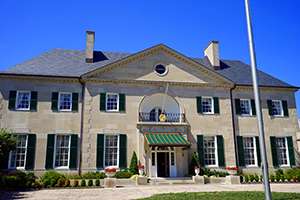 The Symposium was attended by approximately 70 participants including government officials, researchers and private sector representatives from both countries. The Symposium was attended by approximately 70 participants including government officials, researchers and private sector representatives from both countries.
The U.S. participants included the officials of the Department of Energy (DOE), the Nuclear Regulatory Commission (NRC), experts from the National Laboratories and personnel from the nuclear industry such as the Nuclear Energy Institute (NEI); the Japanese participants included government officials from the Japanese Embassy in Washington, D.C. , the Ministry of Education, Culture, Sports, Science and Technology (MEXT) and people belong to Japanese nuclear industry stationed in Washington, D.C., as well as JAEA personnel.
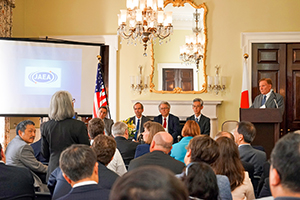 As an opening address, Mr. Yoichi Ito, Executive Vice President, JAEA, expressed his gratitude to those who have been involved in the symposium for their cooperation. He also expressed his expectation for the symposium to deepen cooperation and expand human networking. He also emphasized the significance of international cooperation in conducting R&D on advanced reactors and R&D related to the accident at TEPCO’s Fukushima Daiichi Nuclear Power Station (“Fukushima Daiichi NPS Accident”). Mr. Kazutoshi Aikawa, Minister Plenipotentiary and Deputy Chief of Mission, Embassy of Japan in the U.S., welcomed audience and mentioned the usefulness of nuclear energy in terms of tackling the challenge of global environmental issues which had drawn worldwide attention and the significance of cooperation in wide ranging areas from R&D to nuclear non-proliferation. Hon. Theodore Garish, Assistant Secretary for International Affairs, U.S. DOE also expressed his gratitude first, then reviewed the current status of research cooperation and exchange of technical information, especially that of the decommissioning and decontamination technique, and the pointed out the significance of further cooperation of the U.S. and Japan in these areas. As an opening address, Mr. Yoichi Ito, Executive Vice President, JAEA, expressed his gratitude to those who have been involved in the symposium for their cooperation. He also expressed his expectation for the symposium to deepen cooperation and expand human networking. He also emphasized the significance of international cooperation in conducting R&D on advanced reactors and R&D related to the accident at TEPCO’s Fukushima Daiichi Nuclear Power Station (“Fukushima Daiichi NPS Accident”). Mr. Kazutoshi Aikawa, Minister Plenipotentiary and Deputy Chief of Mission, Embassy of Japan in the U.S., welcomed audience and mentioned the usefulness of nuclear energy in terms of tackling the challenge of global environmental issues which had drawn worldwide attention and the significance of cooperation in wide ranging areas from R&D to nuclear non-proliferation. Hon. Theodore Garish, Assistant Secretary for International Affairs, U.S. DOE also expressed his gratitude first, then reviewed the current status of research cooperation and exchange of technical information, especially that of the decommissioning and decontamination technique, and the pointed out the significance of further cooperation of the U.S. and Japan in these areas.
Keynote addresses were delivered by Ms. Akiko Kawakami, Director, Office for Nuclear Non-proliferation Science and Technology, MEXT, Japan and Dr. Mark Peters, Laboratory Director, Idaho National Laboratory.
Ms. Kawakami introduced Japan’s nuclear policy, the current status and future prospects of R&D on nuclear energy, decommissioning status of Fukushima Daiichi Nuclear Power Station ( “1F”), R&D trends of fast reactors and high-temperature gas-cooled reactors, and fostering of human resources. She emphasized the significance of actively promoting R&D through industry-university-government cooperation.
Dr. Peters made a comprehensive review of the recent rapid progress of the R&D of the next generation reactors in the U.S., to which the Congress gives strong support. He also mentioned the significance of securing and training personnel, as well as developing partnerships between the U.S. and Japan in various fields.
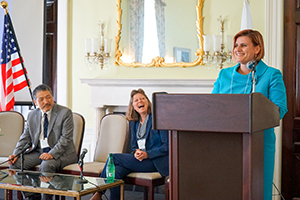 Two panel discussions followed the keynote addresses. One was on Advanced Reactor Technology Research and Development and the other was on Future Technology for Nuclear Safety. Two panel discussions followed the keynote addresses. One was on Advanced Reactor Technology Research and Development and the other was on Future Technology for Nuclear Safety.
The first speaker of advanced reactor technology R&D panel, Mr. Hideki Kamide, Deputy Director General, Sector of Fast Reactor and Advanced Reactor Research and Development, JAEA/Chairman, Policy Group, Generation IV International Forum (GIF), summarized the Japan’s 5th Strategic Energy Plan and a fast reactor strategic roadmap. Then, he introduced the status of JOYO which is aiming for early resumption of operation, experience of irradiation experiment for fast reactors at JAEA and that of high temperature gas cooled reactors. The significance of cooperation on fast neutron experiment was mentioned as well.
Dr. Robert N. Hill, Technical Director, Advanced NE R&D, Argonne National Laboratory gave the outline of the missions of the Office of Nuclear Energy of DOE and R&D of fast reactors. As for R&D of fast reactors, he referred to the activities of advanced materials, evaluation modelling, its verification, and compacted design of the instruments. A molten salt reactor (MSR) campaign, activities of the U.S.-Japan Civil Nuclear Energy Research & Development Working Group (CNWG) and the Versatile Test Reactor (VTR) which will start operation in 2026 were also mentioned. For VTR, in addition to the Memorandum of Cooperation (MOC) that the U.S. and Japan signed in June, the status of the cooperation with France and Korea were also mentioned.
Mr. Raymond V. Furstenau, Director, Office of Nuclear Regulatory Research, U.S. NRC made a presentation titled “Advanced reactors and regulatory compliance of the future technology” and introduced advanced modelling and simulation technology for analysis evaluation from the view point of regulators.
In the following Q&A session, participants showed strong interest in JOYO. Discussion focused on the status of the license application for its restart having been submitted to the Japanese regulatory authority and potential issues for discussion during the licensing review process.
Other points of significance were discussed such as the continued discussion on the roles to be assumed by Japan for the VTR joint research. Considering that other countries such as China and Russia had been developing various kinds of advanced reactors, the significance of the diversification of advanced R&D and the interaction between the regulatory body on the one hand and R&D community and industry on the other, in the United States was discussed as well.
In the second panel discussion, Dr. Joy Rempe, Principal, Rempe and Associates, LLC and Co-Chair, Nuclear Energy Advisory Committee (NEAC), U.S. DOE, introduced lessons learned from the accident at the Three Mile Island Power Plant Unit 2 reactor and Fukushima Daiichi NPS Accident, and the support the U.S. provided for the test related to 1F. This presentation was followed by the presentation by Dr. Koji Okamoto, Director General, Collaborative Laboratories for Advanced Decommissioning Science (CLADS), JAEA. He introduced the overview of CLADS, the progress of its research and efforts to enhance international cooperation.
In the following discussion, participants showed strong interest in the expected roles and missions, and research of CLADS. Discussion was focused on its cooperative relationships with TEPCO and Nuclear Damage Compensation and Decommissioning Facilitation Corporation (NDF), and for its research, on the identification of radiation source of the emitted particles such as silica and the accuracy of modeling at the gas generation in the initial stage of the accident progression.
The main purpose of the CLADS is to contribute to the safe decommissioning of 1F. However, it was emphasized that the research results were to be applied for various fields concerning nuclear safety in the future.
The special event, “Future Scientists and Engineers for Nuclear Energy”, was organized featuring the development and fostering of human resources that will play important roles in the future, which issue is challenging both in the U.S. and Japan. Efforts for securing younger human resources in both countries were introduced along with poster presentations by young researchers with the speed pitch of 2 minutes for each.
In the special event Ms. Madoka Koizumi, Office of Strategy and International Affairs, JAEA stated the structural challenges of fostering human resources that Japan faced and suggested the possibilities of the cooperation between the U.S. and Japan to surmount those challenges. Mr. Osamu Yamashita, President, National Institute of Technology, Fukushima College introduced the overview of the technical college, its human resources development system including Fukushima Innovation Coast Framework and Summer School. Dr. Rachel Slaybaugh, Assistant Professor, UC Berkeley & Program Director, U.S. DOE/ARPA-E introduced “Nuclear Innovation BOOTCAMP”, which was an effort they had been implementing as human resource development program.
Discussion that followed focused on how to foster researchers and engineers for the next generation, among which discussion, the unique existence of the technical college as a bridge connecting junior high schools with industries and its important role to foster human resources for nuclear fields were recognized. The importance of interactive communication in BOOTCAMP and that of constructing education system between DOE and Japanese universities were also discussed.
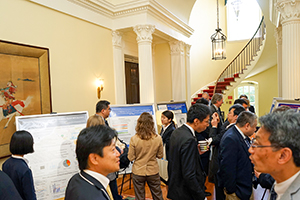 During the coffee break and the reception, JAEA had the poster session presented by “Young Generations” in accordance with the special event’s theme. Active opinion exchange between presenters and attendees took place there. This activity got good evaluations and JAEA believes this surely encouraged the researchers of younger generation and contributed to constructing and expanding human network. During the coffee break and the reception, JAEA had the poster session presented by “Young Generations” in accordance with the special event’s theme. Active opinion exchange between presenters and attendees took place there. This activity got good evaluations and JAEA believes this surely encouraged the researchers of younger generation and contributed to constructing and expanding human network.
Mr. Damien Peko, Technical Advisor for the Office of Nuclear Energy, U.S. DOE and Mr. Paul T. Dickman, Senior Policy Fellow, Argonne National Laboratory wrapped up the symposium, reemphasizing the significance of the cooperation between the U.S. and Japan in various fields including the development of advanced reactors. The symposium was concluded by Dr. Kiyoshi Ono, Director, Office of Strategy and International Affairs, JAEA. He expressed his gratitude to the participants for attending the symposium again and the expectation that the cooperation proposed through the symposium would further develop into new discussion. The symposium was successfully closed.
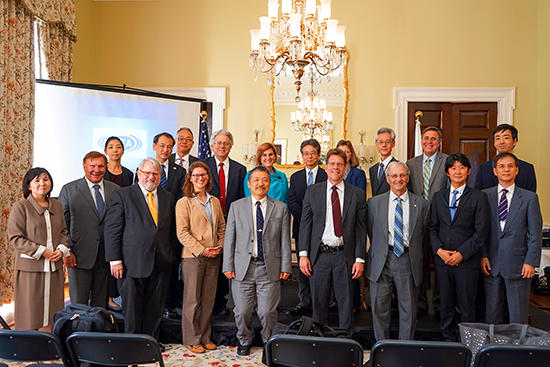
JAEA would like to thank these participants for joining the discussion. JAEA will continue the bilateral discussion with the U.S. on the current and relevant topics through the similar opportunity into the future.
Back
|



